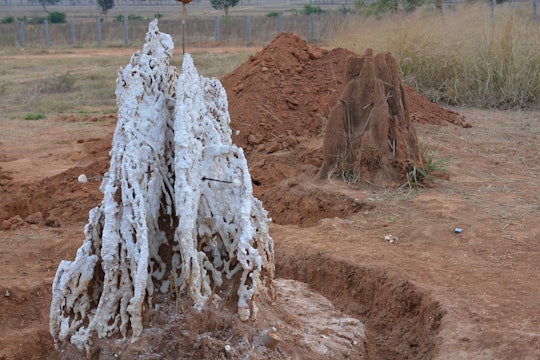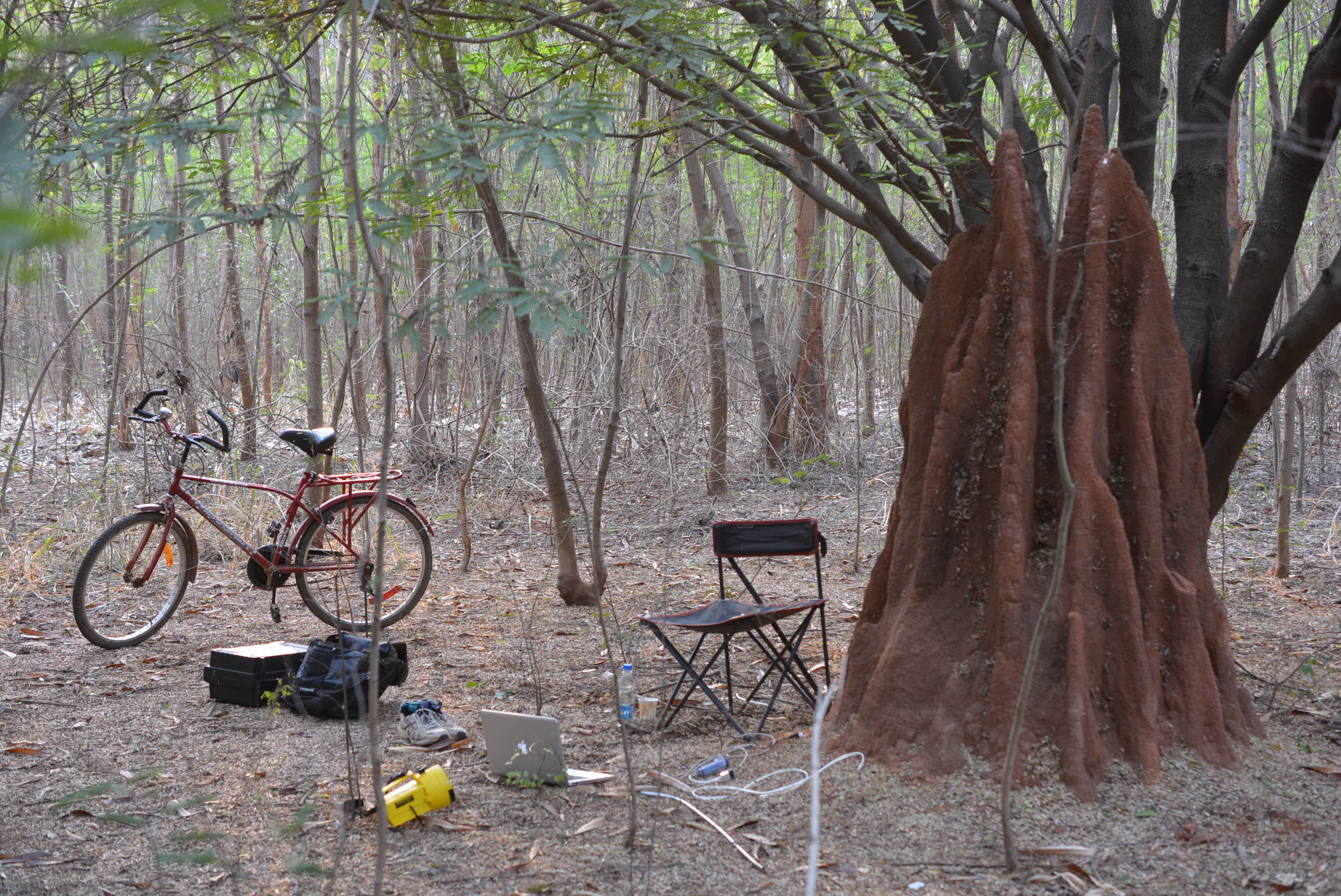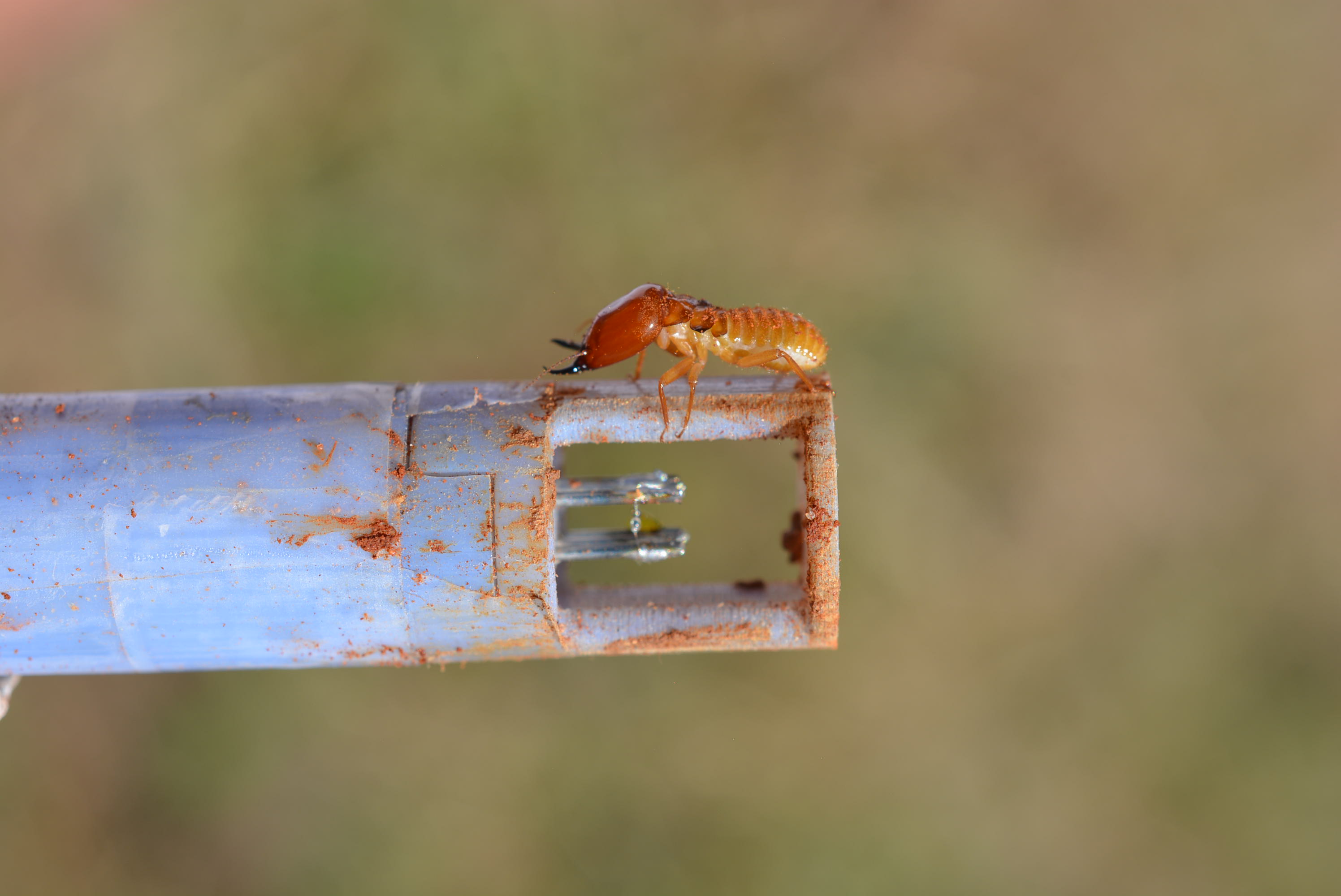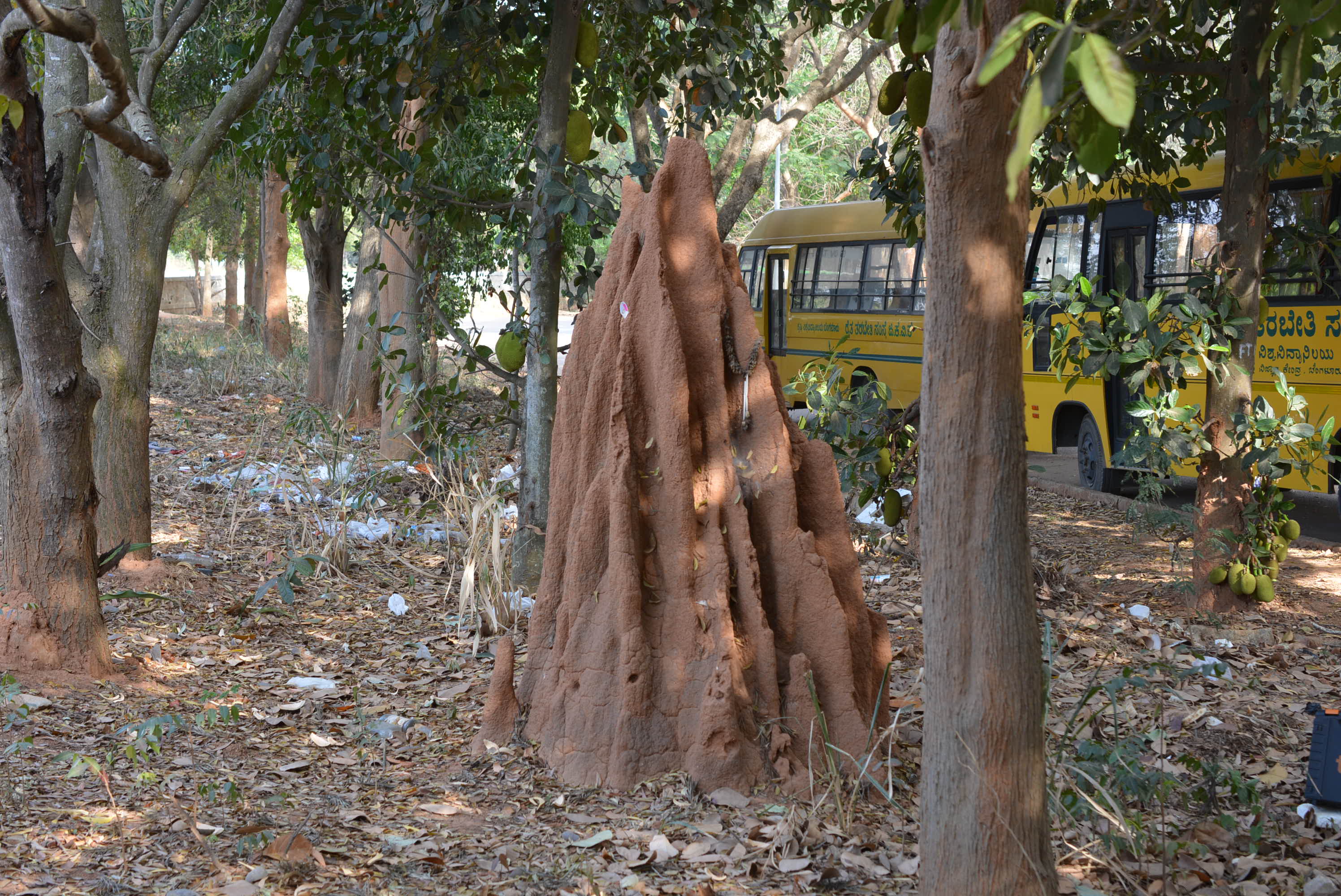
Photo by Hunter King
Can termites teach us to build environmentally friendly communities?
Meet the researchers searching for more climate-friendly architecture
They each stood four Burj Khalifas tall, contained a population the size of San Francisco, and plugged into a network of tunnels sweeping the face of the planet. Any bug-boffin would recognize these giant towers, which formed the backdrop to Robert Silverman's dystopian novel The World Inside, as termite mounds scaled up to human dimensions.
As Silverman’s book hit the shelves in 1971, the architect Paolo Soleri had already broken ground in the desert outside Phoenix, working with locals and students to take his concept of the "arcology", a fusion of architecture and ecology, beyond essays and drawings into experimental physical form. Disillusioned by suburban sprawl, Soleri imagined ultra-dense cities containing millions of people, and he accompanied his meandering texts with exquisitely drawn organic structures resembling vast termite mounds. The new town of Arcosanti was his working model of an arcology in the Arizona desert, but over his life, it grew to only a tiny fraction of the scale he had in mind.
In 1989, as the concrete for Arcosanti’s most recent building slowly set, the construction of a very different kind of arcology gathered pace up the road outside Tucson. Unlike Arcosanti, which asked how communities can live in harmony with the local environment, Biosphere II, named as a hubristic sequel to planet Earth, asked how long people can live inside closed, engineered ecosystems. Plagued by infighting from the start, and despite the best efforts of Steve Bannon, whose investment banking firm was hired to solve the project’s mounting financial troubles, this so-called “planet in a bottle” soon uncorked because of declining levels of oxygen and insect pollinators.
The phrase "arcology" may sound alien, but the idea smolders in the shadows of the public imagination. From time to time, it becomes more than a trope of pulp-fiction, escaping the confines of Hollywood to animate the actions of architects and community organizers who think another world is possible, or scientists and venture capitalists who dream of leaving the troubles of this world behind by building gated eco-communities or moving to Mars.

Where's the cyclist?
Hunter King
Back on earth, termites have been busy developing arcologies of their own. The designs have benefitted from millions of years of trial and error, and the absence of any guiding intelligence or politics. Far from closed systems, termite arcologies do not support "bottled planet" living. Instead, they protect their inhabitants from strong environmental fluctuations while allowing them to exchange energy, matter, and information with the outside world. According to a recent study, the first to take airflow measurements inside a live termite mound, much of the hard work is done using small, fluctuating temperature gradients, instead of the high temperatures reached by burning fossil fuels.
As the global climate crisis heats up, understanding termite arcologies could have profound implications for human architecture and indoor climate control. The knowledge could help us develop new and affordable strategies for keeping cool and surviving dangerous heatwaves, without having to slap on air conditioning units like oversized band-aids. But unlike many technical breakthroughs in cooling, this new blueprint cannot be separated from pressing social questions, such as how to reconcile different thermal tolerances and expectations, while weaving growing populations into new patterns of communal living, working, and dwelling.
The study was led by Lakshminarayanan Mahadevan, known as Maha in the halls of Harvard, where he is a professor of mathematics as it applies to physics and biology. And the thing that drew Maha to mound ventilation was the mystery of morphogenesis, or how termite mounds grow.
Instinctual construction
It's tempting to think of termites as architects and builders. But building implies a blueprint, if not on paper or a hard-drive, then a picture in someone’s mind. Swarm intelligence doesn't work like that. There is no central planning, no executive command. Termites work it out collectively, but again, not in the sense of teamwork toward a commonly understood goal. They blindly follow local cues from each other and the environment. Their behavior shapes the mound, which in turn shapes their surroundings, which in turn shapes their behavior. Off the back of these coupled interactions, a termite mound ratchets up from the ground, undergoing constant re-sculpting and repair.
One regulating cue for growth appears to be the internal airflow patterns generated by the mound. That’s the kind of physical feedback mechanism that Maha famously untangles and codifies. While architects fixate on forms, Maha fixates on formations: how brains wrinkle, guts vilify, and crystals flower.

A termite minion
Hunter King
Ventilation is crucial to the overall health of a termite arcology. Air cycles around the interior complex to eject carbon dioxide, replenish oxygen, and retain moisture so that termites don’t suffocate, desiccate, or starve. (Yes, starve, because some termite species cultivate a fungus crop in underground chambers; they invented agriculture long before humans.) The airflow cycle may also be a communication channel, conveying airborne pheromones that signal, for instance, intruder alert, or where to continue building.
At least that’s the general agreement among scientists. But the all-important details were missing. In an era of high energy particle accelerators and gravitational wave observatories, taking measurements inside live termite mounds turns out to be surprisingly challenging. No one had managed to get around the problem of termites attacking everything that penetrates their walls. So there was no definitive picture of how termite ventilation worked. Could it be powered by metabolic heating, steady breeze, sloshing wind, or beating sun? All of those mechanisms imply different ventilation patterns – and, hence, different ‘scaffolds’ for morphogenesis.
Demystifying termite HVAC
The ventilation hypothesis that most convinced Maha was developed by Syracuse University entomologist J. Scott Turner, a highly regarded authority on insect-built architectures. Turner’s hypothesis was based on experiments with tracer gases that showed how long it took for air to exit a mound, and where.
He thought of a termite mound as a kind of lung that, instead of expanding and contracting, uses buffeting wind as a pumping force. Wind flows by the mound, flicking a turbulent tail that sloshes at the leeward side. This external sloshing happens at certain frequencies which excite the internal chambers, tunnels, and chimneys. So if the wind buffets the mound at, say, note C#, chambers sharing that frequency would react and start sloshing, too, moving their contents up and down or side to side. This mixes up the stagnant carbon dioxide – a product of termite metabolism – and moves it from underground chambers to the top of the mound, where it exits by diffusion through the porous shell.

A termite castle
Hunter King
Presenting to a rapt audience of architects in my class this past fall, Maha explained how he had taken Turner's hypotheses more or less for granted. Yet he wanted more detail about the actual flow patterns, so he could get a better understanding of mound morphogenesis. That meant getting data. But Maha is far too brilliant with a blackboard, and far too busy to get out in the field. He secured funding while convincing a postdoc, Hunter King, and a PhD candidate, Sam Ocko, that measuring termite ventilation was more interesting than any other projects they might have in mind. They would travel to Bangalore, India, where local colleagues would secure access on university grounds to mounds made by a particular fungus-cultivating species.
Sam and Hunter designed a probe that could measure very slight fluctuations in airflow, tuning it for very low velocities in the order of millimeters and centimeters per second. If accuracy is the absence of error, and precision is the level of detail, they worked on getting an output that was very precise, but only somewhat accurate. That’s all they needed to test Turner’s hypothesis. Once securely in the range of small numbers, all that mattered was a reading showing oscillation. Then they could detect internal sloshing and correlate it to buffeting wind.
Talking over the phone, Hunter remembers arriving at the Tata Institute in Bangalore with Sam, and walking through fields and forests managed by the University of Agriculture Sciences. Their chaperone warned against sticking probes into termite mounds, for fear of agitating sleepy cobras. They had a month or so to figure out a testing procedure that would produce some reliable data. Hand drilling a hole and inserting a finger seemed like the only practical way of finding conduits near the surface, in any one of the external buttresses characteristic of mounds built by the termite species Odontotermes obesus. After a few days of wandering around, mentally mapping the constellation of human-height towers, the chaperone left the two scientists to their own devices.
Probes and rampaging termites
Every day they got up, left campus, and went on an excursion, trying this mound, that insertion method. They figured out things impossible to know beforehand, such as how long the probe could linger before being clogged or damaged by rampaging termites.
Their probes worked, but they weren't getting the data they expected. As the weeks went by, Sam started to panic. Hunter, like any good experimentalist, knew how rarely things worked first time around, but he probably should have been panicking, too. Where were the signature airflow oscillations that they, and most termite scientists, expected to find? When their allotted time in India ran out, they returned to Maha’s lab to pore over the data once more.
With the benefit of a little distance and the bland comfort of LED light in a climate-controlled interior, they saw some patterns in the data, which seemed to contradict Turner's hypothesis. Could the flow be smooth and steady instead of choppy and transient? They dusted off older hypotheses in the literature. If the internal airflow was steady, perhaps it was powered by smooth suction from wind streaming past the tip of the mound, or by thermal buoyancy from working termites or baking sunshine.
Sam and Hunter worked patiently over the next year, redesigning their probe so it could properly measure steady flow. It was no mean feat, as you can tell by reading between the lines of the paper's technical appendix. Sloshing flow can be detected by an oscillating electrical signal, as measured by a thermistor, a tiny glass bead with a hot wire that conducts more or less electricity depending on how cool it keeps in an airstream. But detecting steady flow required three thermistors, firing individually and arranged in a row, to know if air was moving up or down, or if it was moving at all. Hunter and Sam sent a pulse of electricity to the middle bead to generate a plume of warm air, which excited the neighboring beads unequally. Now they could compare the signals, subtract the effect of self-heating, and determine the strength and direction of the background airstream.
Sam and Hunter returned to Bangalore more experienced, better equipped, but still without a clear picture of what they would find. Even if they could detect steady flow, it wasn't clear what the driving force would be. They reasoned metabolic heating was the most likely cause. So they took measurements in the forest, where the mounds were shaded from sun and sheltered from wind. Sure enough, they detected steady flows in all of the mounds they measured.
Turner’s hypothesis was probably wrong, but what was working in its place? They plotted the data as a function of time, and saw the flow going up during the day, and down during the night. It seemed to follow the ambient temperature swing, rather than metabolic heating from termites (who never sleep). Sam and Hunter's eyes locked as the explanation slowly dawned on them. There it was, the mechanism for ventilation, staring back at them from the screen, and more tightly bound to the material form than they or any of their peers had dared to imagine.
Here's the explanation in a nutshell: the outside temperature, swinging up and down over the course of a day, thermally activates the mound, powering the ventilation. Here it is again, nutshell unpacked: during the day, the peripheral mass heats up, while the core mass stays cool. This sets up a temperature gradient. Air, filling the interior circuit of chimneys and chambers, responds to the temperature gradient; it rises at the periphery, falls at the core. At night, the temperature gradient flips. So, therefore, does the ventilation cycle.
Carbon dioxide, produced in underground chambers, gets swept up in the ventilation conveyor belt and exits through the material at the base and tip the mound, where pores allow it to diffuse out. Oxygen enters at the same locations. Not much moisture escapes.
The mound is made from granules of earth, bound by termite saliva, tightly or loosely, depending on placement. The material, distributed through the mound, dampens the temperature wave as it swings to and fro from periphery to core. The kind of earth granules don't matter much; they are similar around the world, thermally speaking.
Conundrum solved
Sam and Hunter emailed Maha, but they already knew exactly what to do: replicate their findings. Over a series of excursions lasting 24 hours, they took random walks through the constellation of towers they now knew so well. 15 minutes to set up, five minutes per reading, one reading per mound, never the same one twice, always a buttress facing a different orientation. They wanted to be sure that ventilation followed the same pattern in any buttress at any given time. Up during the day. Down at night. The trend was always the same.
On one excursion, Sam and Hunter found a dead mound, perfectly intact. Now they could measure the temperature of the core as well as the buttresses, continuously over time. The core temperature stayed stable, as the buttresses heated and cooled in sync with the ambient swing. The air cycled round as expected, flipping twice a day, morning and night.
On one of the last evenings before they were due to fly home, Hunter volunteered to monitor carbon dioxide levels in one mound, every 15 minutes, over 24 hours. He anticipated detecting the signature flip. The airflow cycle should pause before switching direction, causing carbon dioxide levels in the underground chamber to accumulate momentarily.

A school bus waiting for termite children
Hunter King
Once the airflow gets going again, the extra carbon dioxide should get puffed up the chimney, causing the sensor to spike. Deliriously tired, eaten alive by mosquitos and who knows what else, and with all his flashlights long dead and Sam offline, Hunter finally observed the spike. It only happened at night, because the airflow didn’t give a strong enough kick during the day. But nevertheless, it was the final piece of the puzzle. They knew how the air flowed around the interior complex, what powered the cycle, and how stale air was purged.
The following year, Hunter and Sam repeated the experiment in Namibia, with mounds that were taller and without buttresses or shade from trees. Just like in India, they failed to get readable data on the first trip and found the same thermal pumping mechanism on the second trip – but with an extra flourish. As the sun scanned the surface of the mound in the early morning and late afternoon, it heated the conduits directly under its beam, forcing those updrafts to dominate, and the chutes on the opposite side to draft down. Normal service resumed when the sun rose directly overhead or fell below the horizon.
To my muted despair, they used the phrase "solar-powered" in the title. It’s true that the sun plays a role, adding a new flow pattern, but surely the ventilation still works on a cloudy day. The journal news editor, writing a summary feature about the study, wrongly suggested that the mound was powered solely by the sun and that this was the same mechanism found in India. Those measurements, remember, were taken in the shade of a dark, teak forest.
An externally imposed power source, like the wind or the sun, is more accessible to the imagination than something internally driven, such as metabolic heating, or a temperature wave coursing through the material form. I deal with this mental block daily, teaching students or working with professionals who should know better. For example, people insist that this building I’m working on has a solar chimney. But we're designing the chimney to work whether the sun is out or not, using heat from occupants, computers, and lighting.
A model with potential
I met Hunter after giving a presentation on breathing buildings and breathing walls at the University of Akron in March. I didn’t know he had moved there, or that he was in the audience. I had concluded by talking about his work in India, fumbling at a synopsis, trying to explain its significance to human arcological design. For me, their discovery shows we have never fully understood the potential of an age-old method of interior climate-control: the sculpting of mass and space. We must try to pick up the trail of development where commodity air-conditioning shut it down. Imagine needing only massive forms, tuned to outside temperature oscillations, to control ventilation, temperature, and humidity.
After the lecture, Hunter and I spoke about the African study, which he had ready for peer review. Then he said something that made my jaw drop. Up until seeing my presentation, he had given up on termite mounds being useful analogies for ventilation in buildings, because every room in every building seems to have the same set-point temperature. And if humans won’t tolerate temperature gradients, they'll never get their ventilation for free.
But now he knows that cookie-cutter buildings aren't the only kind. The thermal comfort standards of corporate buildings aren't even equitably calibrated among white-collar workers. And expensive buildings in rich countries are not the only buildings that need weaning off of fossil fuels. The balance will tip in sub-tropical and mid-latitude areas of the world, where most people live, most people will be born, and most people will enter the middle class.
We could master the technicalities of how termite mounds work and do the math showing how the ventilation schemes scale up to real buildings. But unless we take the opportunity to rethink communal living and working, the effort could all go to waste. Who will tolerate temperature gradients inside their buildings? Atomized individuals, probably not, but hybrid communities, for whom activities are programmed according to thermal needs, perhaps. As cities grow and densify, big arcologies, for better or worse, become inevitable. Different patterns of living, working, and dwelling will have to be reconciled under shared roofs.
So to unplug from combustion engines, buildings may have to become engines themselves – a simple kind of thermal engine, operating on small, fluctuating temperature gradients. In this new paradigm, thermodynamics rule, and form and mass matter – while the culture and politics of shared space can't be ignored.




I was very interested in the implications for future buildings in the last section... I know these types of structures haven't been designed yet, but I was wondering if you had any more details to help me envision what this would look like for people inhabiting it, specifically how great of a temperature gradient do you think would be required? What kind of activities would a hybrid community do in these different spaces?